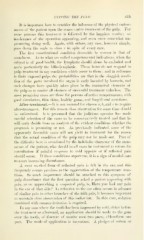Page 417 - My FlipBook
P. 417
CAPPISG THE PULP. 415-
It is important here to consider the influence of the physical endow-
ments of the patient upon the conservative treatment of the pulp. For
some persons this treatment is followed by the happiest results ; no-
intolerance of the operation appearing, and even cases somewhat un-
promising doing well. Again, with others, any case, however simple,,
goes down the scale to class e in spite of every care.
The first constitutional condition favorable to success is that of
soundness. As to what are called temperamental indications, when the
subject is of good health, the lymphatic should alone be excluded and
more particularly the bilio-lymphatic. These latter do not respond to
pulp treatment in any conditions which occur to them ; and in reference
to their exposed pulps the probabilities are that in the sluggish condi-
tion of the parts involved the organ is early invaded by bacteria, and
such changes have quickly taken place in the anatomical elements of
the pulp as to render all chances of successful treatment valueless. The
most promising cases are those for persons of active temperaments, with
good circulation, thin skins, healthy gums, and limpid oral secretions.
After-treatment.—It is not unusual for classes a, b, and c to require
after-treatment. For this reason close observation for some time should
be maintained. It is presumed that the judicious operator has made
careful selection of the cases to be conservatively treated and that he
will early decide from an analysis of the evident conditions whether the
prognosis is promising or not. As previously indicated, some of the
apparently favorable cases will not yield to treatment for the reason
that the actual condition of the pulp may not be made out. Part of
the difficulty here is occasioned by the indefinite character of the state-
ments of the patient, who should in all cases be instructed to return for
consultation if painful response to cold appears or if reflected pain
should occur. If these conditions supervene, it is a sign of needed care
to avert increasing disturbance.
A most marked form of reflected pain is felt in the ear, and this
frequently occurs previous to the aggravation of the temperature reac-
tions. So much importance should be attached to this symptom of
pulp disturbance that the first question asked a patient appearing with,
pain, or on approaching a suspected pulp, is. Have you had any pain
in the ear of that side? As reflection to the ear often occurs in advance
of similar pain in other branches of the fifth pair, it becomes important
to maintain close observation of this indication. In this state, sedation
combined with counter-irritation is required.
In any case where tlie tooth has been impressed by cold, either before
the treatment or afterward, an application should be made to the gum
over the tooth, of tincture of aconite root two parts, chloroform one
part. The mode of application is important. A pledget of cotton or


